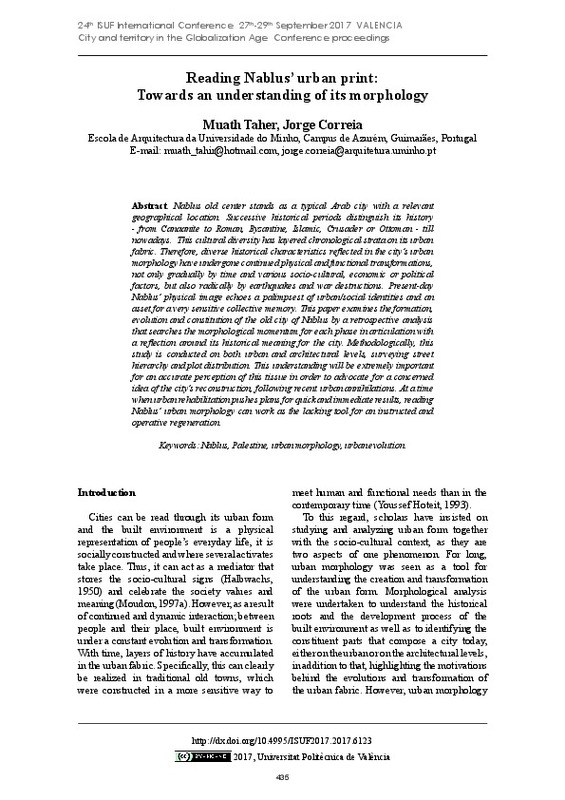JavaScript is disabled for your browser. Some features of this site may not work without it.
Buscar en RiuNet
Listar
Mi cuenta
Estadísticas
Ayuda RiuNet
Admin. UPV
Reading Nablus’ urban print: towards an understanding of its morphology
Mostrar el registro sencillo del ítem
Ficheros en el ítem
| dc.contributor.author | Taher, Muath
|
es_ES |
| dc.contributor.author | Correia, Jorge
|
es_ES |
| dc.coverage.spatial | east=35.26165082248883; north=32.2231714957109; name= Nablus | es_ES |
| dc.date.accessioned | 2018-12-21T08:17:06Z | |
| dc.date.available | 2018-12-21T08:17:06Z | |
| dc.date.issued | 2018-04-20 | |
| dc.identifier.isbn | 9788490485743 | |
| dc.identifier.uri | http://hdl.handle.net/10251/114333 | |
| dc.description.abstract | [EN] Nablus old center stands as a typical Arab city with a relevant geographical location. Successive historical periods distinguish its history - from Canaanite to Roman, Byzantine, Islamic, Crusader or Ottoman - till nowadays. This cultural diversity has layered chronological strata on its urban fabric. Therefore, diverse historical characteristics reflected in the city’s urban morphology have undergone continued physical and functional transformations, not only gradually by time and various socio-cultural, economic or political factors, but also radically by earthquakes and war destructions. Present-day Nablus’ physical image echoes a palimpsest of urban/social identities and an asset for a very sensitive collective memory. This paper examines the formation, evolution and constitution of the old city of Nablus by a retrospective analysis that searches the morphological momentum for each phase in articulation with a reflection around its historical meaning for the city. Methodologically, this study is conducted on both urban and architectural levels, surveying street hierarchy and plot distribution. This understanding will be extremely important for an accurate perception of this tissue in order to advocate for a concerned idea of the city’s reconstruction, following recent urban annihilations. At a time when urban rehabilitation pushes plans for quick and immediate results, reading Nablus’ urban morphology can work as the lacking tool for an instructed and operative regeneration. | es_ES |
| dc.format.extent | 8 | es_ES |
| dc.language | Inglés | es_ES |
| dc.publisher | Editorial Universitat Politècnica de València | es_ES |
| dc.relation.ispartof | 24th ISUF International Conference. Book of Papers | es_ES |
| dc.rights | Reconocimiento - No comercial - Sin obra derivada (by-nc-nd) | es_ES |
| dc.subject | Nablus (Palestine) | es_ES |
| dc.subject | Urban morphology | es_ES |
| dc.subject | Urban evolution | es_ES |
| dc.title | Reading Nablus’ urban print: towards an understanding of its morphology | es_ES |
| dc.type | Capítulo de libro | es_ES |
| dc.type | Comunicación en congreso | es_ES |
| dc.identifier.doi | 10.4995/ISUF2017.2017.6123 | |
| dc.rights.accessRights | Abierto | es_ES |
| dc.description.bibliographicCitation | Taher, M.; Correia, J. (2018). Reading Nablus’ urban print: towards an understanding of its morphology. En 24th ISUF International Conference. Book of Papers. Editorial Universitat Politècnica de València. 435-442. https://doi.org/10.4995/ISUF2017.2017.6123 | es_ES |
| dc.description.accrualMethod | OCS | es_ES |
| dc.relation.conferencename | 24th ISUF 2017 - City and Territory in the Globalization Age | es_ES |
| dc.relation.conferencedate | Septiembre 27-29,2017 | es_ES |
| dc.relation.conferenceplace | Valencia, Spain | es_ES |
| dc.relation.publisherversion | http://ocs.editorial.upv.es/index.php/ISUF/ISUF2017/paper/view/6123 | es_ES |
| dc.description.upvformatpinicio | 435 | es_ES |
| dc.description.upvformatpfin | 442 | es_ES |
| dc.type.version | info:eu-repo/semantics/publishedVersion | es_ES |
| dc.relation.pasarela | OCS\6123 | es_ES |








